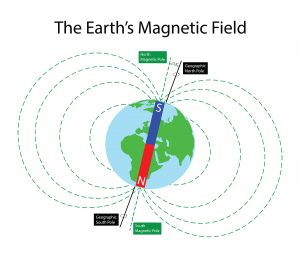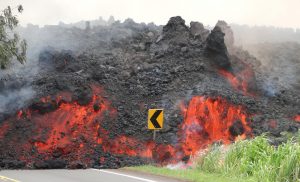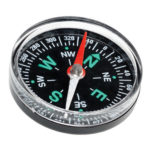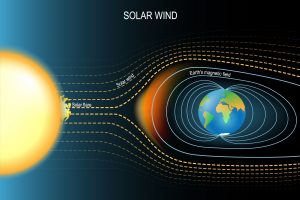Happy Earth Day to Our Favorite Magnet
 Yes It’s Earth Day. And yes, the Earth is a magnet, albeit a weak one. You see, the Earth has solid inner core at its center; surrounded by a dense, super-heated liquid outer core; a mantle of solid bulk around that; and a thin outer later, called the crust. The liquid outer core is made mostly of iron and nickel. As the Earth spins on its axis, the iron and nickel flow in currents that create a magnetic field with lines of force running between two magnetic poles at the top and bottom of the Earth.
Yes It’s Earth Day. And yes, the Earth is a magnet, albeit a weak one. You see, the Earth has solid inner core at its center; surrounded by a dense, super-heated liquid outer core; a mantle of solid bulk around that; and a thin outer later, called the crust. The liquid outer core is made mostly of iron and nickel. As the Earth spins on its axis, the iron and nickel flow in currents that create a magnetic field with lines of force running between two magnetic poles at the top and bottom of the Earth.
It would be convenient if these magnetic poles lined up with the Earth’s north and south poles, but they don’t, at least not perfectly. Since the flow of iron and nickel is not consistent, the Earth’s magnetic field is not consistent, resulting in a shift in the actual location of the magnetic poles, which can move up to 10 miles a year! Sometime in the Earth’s geological future, the north and south poles might even flip—it’s happened in the past. Be careful, Santa! Click to learn more about magnetic fields and our shifting magnetic poles.
 Interesting Fact: Occasionally, molten magma pours out of the Earth’s crust as lava, then cools and becomes rock and these rocks are magnetized by the Earth’s magnetic field. Following these rocks gives a clear picture of our planet’s shifting geomagnetic poles.
Interesting Fact: Occasionally, molten magma pours out of the Earth’s crust as lava, then cools and becomes rock and these rocks are magnetized by the Earth’s magnetic field. Following these rocks gives a clear picture of our planet’s shifting geomagnetic poles.
 Even though the Earth’s magnetic poles are not exactly where the North and South Poles are, they can still be used to help people navigate their way around the world, using magnetic compasses. A compass’ needle, usually a magnetized piece of metal, lines up with the Earth’s magnetic poles, with the north end pointing toward our magnetic north pole.
Even though the Earth’s magnetic poles are not exactly where the North and South Poles are, they can still be used to help people navigate their way around the world, using magnetic compasses. A compass’ needle, usually a magnetized piece of metal, lines up with the Earth’s magnetic poles, with the north end pointing toward our magnetic north pole.
Interesting Fact: Viking sailors are said to have used compass-like tools made of lodestone and iron to determine north and south when navigating their ships in the darkness of winter. Click for some fun tales about the first Earthlings to discover magnets.
 And even though the Earth’s magnetic field is weak (it’s buried roughly 1,800 miles beneath the Earth’s surface), it still serves a powerful purpose. The “magnetosphere” that surrounds the Earth prevents solar wind and harmful solar particles from reaching us on Earth, although some particles do get through, attracted to the poles where the magnetic field is strongest. There they release energy that results in auroras, the colorful phenomenon often known as Northern or Southern Lights. Our magnetic field also protects our atmosphere from erosion.
And even though the Earth’s magnetic field is weak (it’s buried roughly 1,800 miles beneath the Earth’s surface), it still serves a powerful purpose. The “magnetosphere” that surrounds the Earth prevents solar wind and harmful solar particles from reaching us on Earth, although some particles do get through, attracted to the poles where the magnetic field is strongest. There they release energy that results in auroras, the colorful phenomenon often known as Northern or Southern Lights. Our magnetic field also protects our atmosphere from erosion.
The Earth’s magnetic field has other awesome implications as well. Science points to a connection between the geomagnetic field and the sensitivity of our eyes to light. And, even more curious, scientists are investigating the correlation between crazy dreams and geomagnetic activity near the snoozer (the less activity, the crazier the dreams).
 But it’s not just people! All kinds of animals use the Earth’s magnetic field to help navigate and migrate, including sea turtles, salmon, and even flocks of pigeon (talk about animal magnetism!). A fairly recent study found that dogs poop in line with the Earth’s magnetic field and recent findings show that domestic cattle (and maybe deer) line themselves up along the magnetic field lines.
But it’s not just people! All kinds of animals use the Earth’s magnetic field to help navigate and migrate, including sea turtles, salmon, and even flocks of pigeon (talk about animal magnetism!). A fairly recent study found that dogs poop in line with the Earth’s magnetic field and recent findings show that domestic cattle (and maybe deer) line themselves up along the magnetic field lines.
Happy Earth Day to our amazing, magnetic Earth!
Tags: earth day , earth is a magnet , earth’s core , magnetic earth
Share This:
